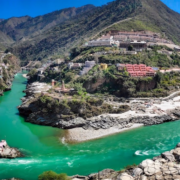
Harsil: Uttarakhand’s Hidden Himalayan Paradise
Nestled in the Himalayas along the banks of the Bhagirathi River, Harsil is an idyllic and serene village in Uttarkashi district, Uttarakhand. At an altitude of about 7,860 feet, this unspoiled gem of the Garhwal region boasts pristine natural beauty, rich cultural heritage, and a peaceful environment perfect for those seeking an escape from city life. Known for its enchanting landscape, dense deodar forests, and proximity to the sacred Gangotri, Harsil offers travelers a chance to immerse themselves in nature and spirituality alike.
The Natural Beauty of Harsil
Harsil’s natural landscape is defined by towering deodar and pine forests, clear rivers, and majestic snow-capped peaks. The village is situated on the banks of the Bhagirathi River, whose waters originate from the Gangotri Glacier, just 25 kilometers away. The river adds an enchanting charm to Harsil, with its serene, crystal-clear waters meandering through the valley and its sound resonating through the region. The dense forests surrounding Harsil, inhabited by a variety of wildlife, make it an excellent spot for nature enthusiasts and bird watchers.
The mountain peaks, particularly during sunrise and sunset, create a picturesque landscape that feels almost surreal. As the sun rises, it illuminates the snow-capped mountains in golden hues, making it an unforgettable sight for photographers and travelers alike. During winter, Harsil is often blanketed in snow, transforming it into a beautiful winter wonderland.
Spiritual Significance and Gangotri Proximity
One of the reasons Harsil is such a popular destination is its proximity to Gangotri, one of the four Char Dham pilgrimage sites for Hindus. Gangotri, the place where the River Ganga is believed to have descended on Earth, attracts thousands of pilgrims every year. The trek or drive from Harsil to Gangotri is scenic and spiritually fulfilling, passing through breathtaking landscapes and ancient temples.
For those interested in exploring spirituality closer to Harsil, there’s the Mukhwa Village, where the idol of Goddess Ganga is worshipped during winters when the Gangotri Temple remains inaccessible. Mukhwa Village, just a few kilometers from Harsil, is thus integral to the religious landscape of the region.
Rich Cultural Heritage
The cultural fabric of Harsil is woven with both Hindu and Bhutia influences. The Bhutia community, originally traders from Tibet, settled in the region and contributed to the area’s unique culture and cuisine. The Bhotias, known for their hospitality, can often be found dressed in traditional attire and speaking in their native language. Their traditional homes, characterized by unique architectural styles with intricate wooden carvings, add to the charm of the village.
A prominent local dish is dal bhat, a simple yet flavorful lentil dish, along with thukpa, a noodle-based soup often enjoyed in winter. Local festivals in Harsil, such as Diwali and Magh Mela, are celebrated with great enthusiasm, providing travelers with a glimpse into the vibrant culture of the region.
Activities and Adventure
Harsil offers a plethora of activities for adventure seekers and nature lovers. Trekking is one of the most popular activities, with trails leading to nearby destinations like Gangotri, Kedarkantha, and Dayara Bugyal. These treks vary in difficulty, catering to both novice and seasoned trekkers, and provide breathtaking views of the surrounding landscapes.
River rafting on the Bhagirathi is an adrenaline-pumping activity for thrill-seekers, especially in the summer months when the river swells. Nature walks along the Bhagirathi or through the deodar forests offer a more relaxing way to connect with the beauty of Harsil. Photographers are drawn to Harsil’s stunning landscapes, capturing the beauty of the valley, river, and mountains. Harsil is also a great place for stargazing, with clear skies and minimal light pollution, making the stars seem within reach.
How to Reach Harsil
Harsil is accessible by road and serves as an ideal stop on the route to Gangotri. The nearest airport is Jolly Grant Airport in Dehradun, about 235 kilometers away, while the closest railway station is in Rishikesh, roughly 210 kilometers from Harsil. From both these locations, visitors can take buses or hire cabs to reach Uttarkashi and then continue to Harsil.
Where to Stay
Harsil offers a range of accommodations, from guesthouses to small hotels, catering to various budgets. Many of these accommodations provide basic amenities and cozy, comfortable rooms with scenic views. Homestays, where travelers can experience the local culture firsthand, are becoming popular. For those seeking a more immersive experience, there are camping options, allowing visitors to spend nights under the stars in the heart of nature.
Best Time to Visit
The ideal time to visit Harsil is during the summer months from April to June and the post-monsoon season from September to November. During these months, the weather remains pleasant, making it ideal for trekking and other outdoor activities. Winter in Harsil is magical, but temperatures can drop significantly, and heavy snowfall may make some areas inaccessible.
Conclusion
Harsil is a sanctuary for nature lovers, trekkers, and spiritual seekers alike. With its stunning landscapes, peaceful ambiance, and spiritual significance, Harsil provides an experience that is both humbling and uplifting. It is a destination that beautifully combines nature and spirituality, offering travelers a glimpse of Uttarakhand’s serene and sacred side. Whether you’re trekking through pine forests, rafting in the Bhagirathi River, or simply enjoying the beauty of the mountains, Harsil promises an experience that lingers long after you’ve left.
Recent Posts
Exploring Pangot: A Tranquil Bird Watcher’s Paradise in Uttarakhand
Devprayag: The Sacred Confluence of Rivers and Cultures
Rudraprayag: A Confluence of Spirituality and Natural Beauty
All Categories

Thailand




